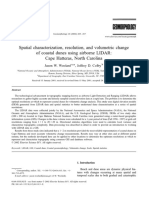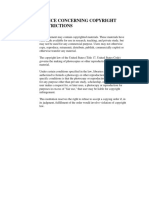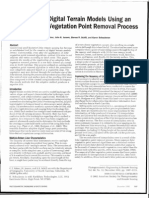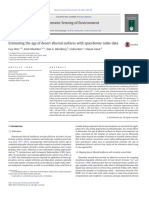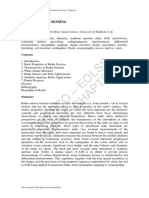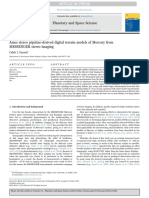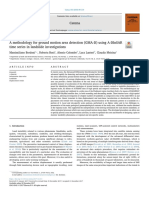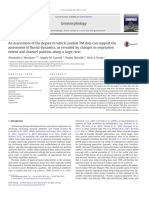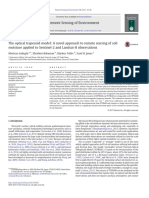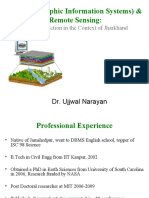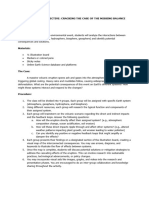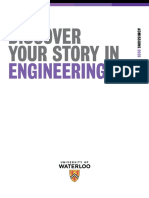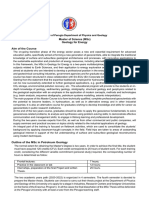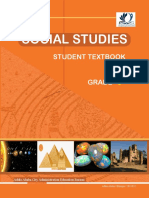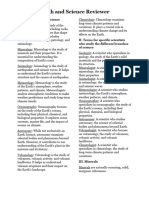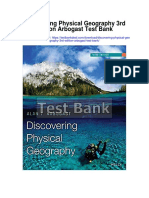Active Tectonics and The LiDAR Revolution
Active Tectonics and The LiDAR Revolution
Uploaded by
Shaoyang DongCopyright:
Available Formats
Active Tectonics and The LiDAR Revolution
Active Tectonics and The LiDAR Revolution
Uploaded by
Shaoyang DongOriginal Title
Copyright
Available Formats
Share this document
Did you find this document useful?
Is this content inappropriate?
Copyright:
Available Formats
Active Tectonics and The LiDAR Revolution
Active Tectonics and The LiDAR Revolution
Uploaded by
Shaoyang DongCopyright:
Available Formats
Active tectonics and the LiDAR revolution
Andrew Meigs*
COLLEGE OF EARTH, OCEAN, AND ATMOSPHERIC SCIENCES, 104 CEOAS ADMINISTRATION HALL, OREGON STATE UNIVERSITY, CORVALLIS, OREGON 97331, USA
ABSTRACT
A revolution in remote sensing, light detection and ranging (LiDAR) laser altimetry swath mapping, reveals the details of topographic fea-
tures at such high resolution that they have transformed our understanding of tectonic forcing of the shape of the Earth’s surface. Meter-
scale DEMs (digital elevation models) capture fault offsets, fault zone structure, off-fault deformation, and landscape properties at microgeo-
morphic scale, highlighting that the surface faithfully records the complexity and sensitivity of deformation in detail.
LITHOSPHERE doi: 10.1130/RF.L004.1
New techniques for surface imaging and ing facility, came into existence in 2003 (Carter etrating vegetation, and presumably hitting the
analysis continue to inform and challenge our et al., 2007). The applications of LiDAR data ground. An example of the spatial and verti-
understanding of the Earth’s surface evolution. seem boundless. LiDAR data are used in fields cal resolution of high quality data is provided
A Mw 7.3 earthquake in the eastern California that include engineering, planning, forestry and by surveys funded and hosted by the Oregon
shear zone (the 1992 Landers earthquake [Sieh ecology, glaciology, geomorphology, and active LiDAR Consortium. The Consortium, formed
et al., 1993]), for example, saw the debut of tectonics. What are these data and why are they by the Oregon Department of Geology and
synthetic aperture radar (SAR) interferometry so alluring? Mineral Industries in partnership with a host
as a means for measuring the coseismic dis- The principle underlying LiDAR surveying of public and private entities, requires data
placement field of an earthquake (Massonnet is relatively straight-forward; a laser rapidly collected with eight point-per-square-meter
et al., 1993). Stunning SAR images revealed emits light pulses that are reflected back from density and <6-cm RMSE (root-mean-square
both the displacement along the fault, measure- any object they strike. The travel time between error) vertical accuracy (Fig. 1) (Luccio, 2013;
ments typically made via labor-intensive field the instrument and the object are used in com- Madin et al., 2010). Data with this resolu-
methods, as well as off-fault deformation in a bination with the instrument location and ori- tion generated through the consortium cover
90 × 100 km area surrounding the 80-km-long entation to determine the absolute position of more than 16,000,000 acres in Oregon (http://
surface rupture. Whereas the use of landforms every object that reflects the light (Ackermann, www.oregongeology.org/dogamilidarviewer/;
as strain markers to characterize active fault- 1999; Carter et al., 2007; Harding, 2000). Luccio, 2013).
ing and folding was established decades earlier LiDAR data used in the Earth sciences are most A recent paper published in Lithosphere by
(e.g., Wallace, 1968), the Landers SAR images often collected via either ground-based terres- Barth et al. (2012, v. 4, p. 435–448) provides
demonstrated that the Earth’s surface records trial laser scanning surveys (TLS) or airborne wonderful illustration of the power of high-
earthquake deformation to a greater degree laser swath mapping (ALSM) of large tracts. resolution LiDAR topographic data. Profound
than previously known. Suddenly, time series Airborne LiDAR data are collected by affixing lineaments mark the topographic expression of
analysis of surface imagery became a key tool a laser to an aircraft, controlling for the air- strike slip faults such as the San Andreas fault
for inversion of coseismic and postseismic data craft location using differential kinematic GPS in California (Wallace, 1990) and the Alpine
sets, for modeling static stress changes on faults (global positioning systems) with on-board and fault in New Zealand, the focus of the Barth et
and on neighboring faults, and a host of other ground-based base stations, and flying a series al. study. Shuttle Radar Topography Mission
geological and geophysical applications (e.g., of overlapping swaths over the survey area DEM (30-m resolution) data reveal the remark-
Fialko et al., 2002). (Harding, 2000). Because current lasers send able linearity of the Alpine fault (http://photo-
Light detection and ranging (LiDAR) topo- up to 150,000 pulses per second (Carter et al., journal.jpl.nasa.gov/catalog/PIA06661). In con-
graphic surveying takes Earth surface imaging 2007), ALSM bathes the survey area with laser trast, DEMs generated from LiDAR along a 20
to a new level because of its resolution and its pulses that produce returns off of any object km-long reach of the Alpine fault between the
wide availability in the public domain. A search between the aircraft and the Earth’s surface. Waiho River at Franz Joseph and the Whataroa
in Google Scholar using the key words “light Flying over a forest, for example, yields a 3 River to the northeast illustrate the nonlin-
detection and ranging” results in ~780,000 dimensional set of points that includes returns ear, step-like surface expression of the fault at
hits—an astounding number given that the first from the forest canopy, the ground surface, and scales of 1–10’s of meters. Whereas the scale-
papers in the Earth sciences to use these data from any object in between. A “point cloud” dependent nature of the topology fault is well
started appearing after ~1995 (e.g., Krabill et data set results from the swath mapping. Most known (Norris and Cooper, 1995), the unique
al., 1995). The National Center for Airborne Earth science users utilize the “bare earth” contribution of the Barth et al. (2012) study is
Laser Mapping (NCALM), a National Science model, which is a very high-resolution digi- that the new high-resolution data allow for the
Foundation (NSF) data collection and process- tal elevation model (DEM) created from the kinematic relationship between strike- and dip-
last returns during a survey—the pulses that slip faults to be characterized at the scale of 10’s
*E-mail: meigsa@geo.oregonstate.edu traveled the farthest from the scanner, pen- of meters. Not only did these new data reveal the
226 www.gsapubs.org | |Volume
For permission to copy, contact editing@geosociety.org | NumberSociety
© 20135Geological 2 | LITHOSPHERE
of America
Downloaded from http://pubs.geoscienceworld.org/gsa/lithosphere/article-pdf/5/2/226/3039630/226.pdf
by guest
Active tectonics and the LiDAR revolution | RESEARCH FOCUS
access for these data (http://pugetsoundlidar.org/).
The Oregon LiDAR Consortium followed the
open access model (http://www.oregongeology
.org/sub/projects/olc/). The National Center for
Laser Altimetry (NCALM) maintains instru-
ments for use by research investigators, has a
seed program for graduate student research proj-
ects, and a litany of other products and services
for the research community (http://www.ncalm
.cive.uh.edu/). NCALM, regional consortia, and
other LiDAR databases now collaborate with
OpenTopography, which is an NSF-supported
data warehouse that distributes analysis software,
houses tutorials and short courses, and other prod-
ucts in addition to distributing data (http://www
.opentopography.org/). The data sets are large, but
the analysis programs are becoming increasingly
optimized to handle these data. Tools available
through OpenTopography allow users to visual-
ize LiDAR point clouds and process bare earth
DEMs from the original data. OpenTopography
facilitates processing large data sets through the
Figure 1. Comparison of 30 m Shuttle Radar Topography Mission (A) and 1 m LiDAR data (B) from
San Diego Super Computer Facility.
the Oregon LiDAR Consortium of an active fault in the Klamath Basin in south-central Oregon. Note To get started learning how to visualize
that the presence of a fault is indicated by the strong gray-scale contrast running from top left to and analyze of LiDAR data, OpenTopography
lower right across the 30 m data. In the 1 m LiDAR digital elevation model, multiple fault splays, has materials from a number of excellent short
right lateral offset of the streams, and the normal separation across the fault zone is well resolved courses and tutorials archived on their education
topographically. Figure produced by Trevor Waldien (Oregon State University). and training page (http://www.opentopography
.org/index.php/resources/). A particularly good
place to start is the short course taught by Ian
detailed structural relations along the fault seg- previously unknown active fault traces. “High- Madin of the Oregon Department of Geologi-
ments, dozens of new fault segments and folds Resolution Lidar Topography of the Puget cal and Mineral Industries; Ralph Haugerud,
were discovered. The data and analysis suggest Lowland, Washington” found, for the first time, U.S. Geological Survey; Chris Crosby, Open
that through-going surface rupture of the Alpine splays of the Seattle fault system, which last had Topography, San Diego Supercomputer Center;
fault involves transfer of slip between neighbor- an earthquake ~1100 years ago (Bucknam et al., and Mike Oskin of the University of California,
ing strike-slip sections of the fault via dip-slip 1992), provided topographic control for location Davis (UC Davis) at the 2009 Annual Meeting
faulting and associated hanging-wall folding in of trench sites, and spawned a flurry of papers of the Geological Society of America. Topics
newly discovered structural wedges. on the earthquake hazards, structure, and paleo- covered in this tutorial include characteristics
A few early papers recognized the signifi- seismic history of numerous faults throughout of a raw data set, DEM creation, visualization
cance of LiDAR technology in understanding the Puget Lowland (e.g., Johnson et al., 2004). strategies, and data acquisition and quality. A
patterns of active faulting, which the Barth et al. Finally, the “B4” LiDAR surveyed the southern second valuable short course geared toward
(2012) paper adds to the large and rapidly grow- San Andreas and San Jacinto fault systems in using LiDAR data in active fault studies is the
ing body of literature based on LiDAR data. order to provide a high-resolution pre-earth- “Imaging and Analyzing Southern Califor-
The first group to use ALSM data conducted quake topographic data set (Bevis et al., 2005). nia’s Active Faults with High-Resolution Lidar
a LiDAR survey as part of the post-seismic The southern segment of the San Andreas fault Topography” tutorial from the course held at
response to the Mw 7.1 Hector Mine earthquake was chosen because it is the only reach of the UC Davis in 2011. In addition to covering DEM
in southern California in 1999 (Hudnut et al., fault that has not ruptured historically and creation and visualization, this course intro-
2002). Hudnut et al.’s (2002) paper represented because more than 400 years have apparently duces the user to LaDiCaoz, which is a software
a breakthrough because they demonstrated that elapsed since the last earthquake (Weldon et package developed by Ramon Arrowsmith and
high-resolution topographic surveying using al., 2005). Capturing the details of the surface his students at Arizona State University to quan-
ALSM yielded topographic data with an accu- rupture and the topographic change follow- tify lateral displacements across faults from
racy and resolution that exceeded what could ing the next southern San Andreas earthquake LiDAR DEMs (Zielke and Arrowsmith, 2012).
be generated using traditional methods. More- was the central objective of the B4 project, an Tools for back slipping and offset reconstruc-
over, the comprehensive mapping along the full experimental design that foreshadowed emerg- tion are one of the notable capabilities unique to
length of the rupture showed that ALSM-based ing cutting-edge research that exploits pre- and LaDiCaoz and of use for making high accuracy,
measurement of offset agreed well with field post-seismic surveys along faults (Nissen et al., high precision measurements of offset. A third
measurements and allowed for visualization in 2012; Oskin et al., 2012). useful course focuses on applications of LiDAR
three dimensions. A second key paper appeared LiDAR data sources are proliferating and analysis in geomorphology. The “New Tools in
the following year. Haugerud et al. (2003) much of the data are in the public domain. The Process-Based Analysis of Lidar Topographic
showed that LiDAR sees through trees and finds Puget Sound LiDAR Consortium pioneered open Data” short course held in 2010 at the University
LITHOSPHERE | Volume 5 | Number 2 | www.gsapubs.org 227
Downloaded from http://pubs.geoscienceworld.org/gsa/lithosphere/article-pdf/5/2/226/3039630/226.pdf
by guest
A. MEIGS
structure and evolution, and fault slip accrued
A B on earthquake and longer timescales. Quantita-
tive analysis of fault offsets at sub-meter scale
are now possible along the length of any fault
system surveyed with LiDAR, which allows for
measurement of slip in the last earthquake event
along faults where those data do not exist (Had-
dad et al., 2011). LiDAR data analyzed with
tools such as LaDiCaoz enable new measure-
ment of offset in key historical earthquakes. A
C study that revisited the 1857 Fort Tejon earth-
quake on the south-central San Andreas fault,
for example, found additional offsets to those
from conventional field study and indicated that
the coseismic offsets from the last earthquake
along the Carrizo Plain were about half the
widely accepted values (Fig. 2A–C) (Sieh, 1978;
X'
11
Zielke et al., 2010, 2012). LiDAR data also per-
D
1'
5
°3
°3
11
mit direct measurement of landscape evolution
P
32
9'
DI
5
°3
and response times to tectonic perturbations
8'
(Hilley and Arrowsmith, 2008), tectonic geo-
Borreg morphologic phenomenon that are only inferred
o Fault
DIP
from numerical models at present (Whipple and
Meade, 2006). Given that topographic scale is
one variable that influences landscape response
Paso time (Whipple, 2001), structural-topographic
Infer features such as pressure ridges along strike slip
ior A
0'
ccom
°3
faults act as “mini” mountain ranges to explore
32
mod
ation hillslope, channel, and drainage basin response
DIP
Zone to tectonic forcing. The great advantage is that
+1.5 m
P
drainage basins evolve on length scales of
DI
Δ Elevation
meters to tens of meters and timescales of hun-
N
dreds to thousands of years. Finally, before and
O
R
TH
after earthquake differential LiDAR surveys, as
DIP
Lag
Sala una anticipated by the B4 experiment along the San
500 m da F
-2.5 m X ault Andreas fault system, represents a very exciting
frontier. A “before” LiDAR survey along the El
E Paso Inferior (east dip) Borrego 100pt Median Mayor–Cucapah fault fortuitously allowed for a
Δ Elev. (m)
0 differential analysis of the surface affects associ-
-1 X ated with a Mw 7.2 earthquake in Baja California
-4 -2.7 x 10-4 in 2010 (Fig. 2D–E) (Oskin et al., 2012). Oskin
-2 Laguna Salada 5.3 x 10 400µstr -4 X'
0m 1000 m 2000 m 6.6 x 10 et al. (2012) used differencing of the before and
after point cloud data to characterize both the
Figure 2. Two examples of cutting edge LiDAR analysis. Figures 2A–C, highlight the Zielke et al. (2010)
channel offset by the San Andreas fault in the Carrizo Plain during the 1857 Fort Tejon earthquake
on- and off-fault deformation resulting from the
(Fig. 2A), a plot from LaDiCaoz showing the fit of the channel after backslipping the walls of the fault earthquake. The analysis revealed the subtleties
(red and blue profiles; Fig. 2B), and the best-fit slip estimate for the channel (Fig. 2C). Fault offset and complexities of the surface rupture as well
and distributed deformation revealed by differential LiDAR analysis of before and after surveys in the as blind faulting and distributed deformation
region of the El Mayor–Cucapah earthquake. Oskin et al.’s (2012) work quantified the magnitude of that conventional post-earthquake studies were
change (Fig. 2D), which in the low relief, low surface sloping regions resulted from the combination unlikely to resolve. As explained in the Oskin
of fault offset, tilt, and bending moment strain (Fig. 2E). Modified from Zielke et al. (2010) and Oskin
et al. (2012) paper, the pre-earthquake data are
et al. (2012) with permission from the American Association for the Advancement of Science (AAAS).
of low resolution, data with very accurate ele-
vations despite having low point density. One
can only imagine what will be learned when
Corporation for Atmospheric Research (UCAR) tat information, techniques for data filtering and an earthquake happens along a fault with high-
by Dorothy Merritts (Franklin and Marshall smoothing, and change detection strategies. resolution before and after LiDAR data.
College) and Noah Snyder (Boston College) What are the frontiers of LiDAR analy-
included modules for geomorphic analysis, sis in tectonically active landscapes? Clearly, ACKNOWLEDGMENTS
in addition to covering active fault character- studies of active fault traces such as that in the Several people contributed to this review and are thanked.
Trevor Waldien (OSU) created the images in Figure 1. Data
ization. Topics in geomorphic analysis include Barth et al. (2012) study will continue to pro- used in Figure 1B are from the DOGAMI Oregon LiDAR Con-
extraction of river channel properties and habi- vide new insight in fault kinematics, fault zone sortium. Olaf Zielke provided Figure 2A–C and Mike Oskin
228 www.gsapubs.org | Volume 5 | Number 2 | LITHOSPHERE
Downloaded from http://pubs.geoscienceworld.org/gsa/lithosphere/article-pdf/5/2/226/3039630/226.pdf
by guest
Active tectonics and the LiDAR revolution | RESEARCH FOCUS
provided Figure 2D–E. Ramon Arrowsmith, Eduardo Guer- Topography of the Puget Lowland, Washington—A mation from the El Mayor–Cucapah earthquake
erro, Nick Legg, and Chris Madden read and commented on Bonanza for Earth Science: GSA Today, v. 13, p. 4–10, revealed by differential LIDAR: Science, v. 335, p. 702–
an earlier draft of the manuscript. doi:10.1130/1052-5173(2003)13<0004:HLTOTP>2.0.CO;2. 705, doi:10.1126/science.1213778.
Hilley, G.E., and Arrowsmith, J.R.n., 2008, Geomorphic Sieh, K.E., 1978, Slip along the San Andreas fault associated
response to uplift along the Dragon’s Back pressure with the great 1857 earthquake: Bulletin of the Seismo-
REFERENCES CITED ridge, Carrizo Plain, California: Geology, v. 36, p. 367– logical Society of America, v. 68, p. 1421–1448.
Ackermann, F., 1999, Airborne laser scanning-present status 370, doi:10.1130/G24517A.1. Sieh, K., Jones, L., Hauksson, E., Hudnut, K., Eberhart-Phil-
and future expectations: ISPRS (International Society Hudnut, K.W., Borsa, A., Glennie, C., and Minster, J.B., 2002, lips, D., Heaton, T., Hough, S., Hutton, K., Kanamori, H.,
for Photogrammetry and Remote Sensing) Journal of High-resolution topography along surface rupture of and Lilje, A., 1993, Near-field investigations of the Land-
Photogrammetry and Remote Sensing, v. 54, p. 64–67, the 16 October 1999 Hector Mine, California, earthquake ers earthquake sequence, April to July 1992: Science,
doi:10.1016/S0924-2716(99)00009-X. (Mw 7.1) from airborne laser swath mapping: Bulletin of v. 260, p. 171, doi:10.1126/science.260.5105.171.
Barth, N.C., Toy, V.G., Langridge, R.M., and Norris, R.J., 2012, the Seismological Society of America, v. 92, p. 1570– Wallace, R.E., 1968, Notes on stream channels offset by the
Scale dependence of oblique plate-boundary partition- 1576, doi:10.1785/0120000934. San Andreas fault, southern Coast Ranges, California:
ing: New insights from LiDAR, central Alpine fault, New Johnson, S.Y., Blakely, R.J., Stephenson, W.J., Dadisman, Proceedings of the Conference on Geologic Problems
Zealand: Lithosphere, v. 4, p. 435–448, doi:10.1130/L201.1. S.V., and Fisher, M.A., 2004, Active shortening of the of the San Andreas Fault System, p. 6–21.
Bevis, M., Hudnut, K., Sanchez, R., Toth, C., Grejner-Brzezinska, Cascadia forearc and implications for seismic hazards Wallace, R.E., 1990, The San Andreas fault system: California:
D., Kendrick, E., Caccamise, D., Raleigh, D., Zhou, H., of the Puget Lowland: Tectonics, v. 23, doi:10.1029 U.S. Geological Survey Professional Paper 1515, 283 p.
Shan, S., Shindle, W., Yong, A., Harvey, J., Borsa, A., /2003TC001507. Weldon, R.J., Fumal, T.E., Biasi, G.P., and Scharer, K.M., 2005,
Ayoub, F., Shrestha, R., Carter, B., Sartori, M., Phillips, Krabill, W., Thomas, R., Martin, C., Swift, R., and Frederick, E., Past and future earthquakes on the San Andreas fault:
D., and Coloma, F., 2005, The B4 Project: Scanning the 1995, Accuracy of airborne laser altimetry over the Green- Science, v. 308, p. 966–967, doi:10.1126/science.1111707.
San Andreas and San Jacinto Fault Zones: Eos (Transac- land ice sheet: International Journal of Remote Sensing, Whipple, K.X., 2001, Fluvial landscape response time: How
tions, American Geophysical Union), Fall Meeting 2005, v. 16, p. 1211–1222, doi:10.1080/01431169508954472. plausible is steady-state denudation: American Journal
abstract #H34B-01. Luccio, M., 2013, The Oregon Lidar Consortium: Professional of Science, v. 301, p. 313–325, doi:10.2475/ajs.301.4-5.313.
Bucknam, R.C., Hemphill-Haley, E., and Leopold, E.B., 1992, Surveyor Magazine, v. 33. Whipple, K.X., and Meade, B.J., 2006, Orogen response to
Abrupt uplift within the past 1700 years at southern Puget Madin, I.P., English, J.T., and Boyd, M., 2010, How low can you changes in climatic and tectonic forcing: Earth and Plan-
Sound, Washington: Science, v. 258, 1611, doi:10.1126 go? Testing the limits of spatial and temporal resolu- etary Science Letters, v. 243, p. 218–228, doi:10.1016/j
/science.258.5088.1611. tion for airborne LiDAR: Geological Society of America .epsl.2005.12.022.
Carter, W.E., Shrestha, R.L., and Slatton, K.C., 2007, Geodetic Abstracts with Programs, v. 42, no. 5, p. 155. Zielke, O., and Arrowsmith, J.R., 2012, LaDiCaoz and LiDAR-
laser scanning: Physics Today, v. 60, p. 41, doi:10.1063 Massonnet, D., Rossi, M., Carmona, C., Adragna, F., Peltzer, imager—MATLAB GUIs for LiDAR data handling and
/1.2825070. G., and Feigl, K., 1993, The displacement field of the lateral displacement measurement: Geosphere, v. 8,
Fialko, Y., Sandwell, D., Agnew, D., Simons, M., Shearer, P., Landers earthquake mapped by radar interferometry: p. 206–221, doi:10.1130/GES00686.1.
and Minster, B., 2002, Deformation on nearby faults Nature, v. 364, p. 138–142, doi:10.1038/364138a0. Zielke, O., Arrowsmith, J.R., Ludwig, L.G., and Akciz, S.O.,
induced by the 1999 Hector Mine earthquake: Science, Nissen, E., Krishnan, A.K., Arrowsmith, J.R.n., and Saripalli, 2010, Slip in the 1857 and Earlier Large Earthquakes
v. 297, p. 1858–1862, doi:10.1126/science.1074671. S., 2012, Three-dimensional surface displacements and Along the Carrizo Plain, San Andreas Fault: Science,
Haddad, D., Madden, C., Salisbury, J., Arrowsmith, R., and rotations from differencing pre-and post-earthquake v. 327, p. 1119–1122, doi:10.1126/science.1182781.
Weldon, R., 2011, LiDAR-derived measurements of slip LiDAR point clouds: Geophysical Research Letters, Zielke, O., Arrowsmith, J.R., Ludwig, L.G., and Akciz, S.O.,
in the most recent ground-rupturing earthquakes along v. 39, L16301, doi:10.1029/2012GL052460. 2012, High-Resolution Topography-Derived Offsets
elements of the San Andreas fault system: Eos (Trans- Norris, R.J., and Cooper, A.F., 1995, Origin of small-scale along the 1857 Fort Tejon Earthquake Rupture Trace, San
actions, American Geophysical Union), Fall Meeting segmentation and transpressional thrusting along the Andreas Fault: Bulletin of the Seismological Society of
2011, abstract #T31B-2344. Alpine fault, New Zealand: Geological Society of Amer- America, v. 102, p. 1135–1154, doi:10.1785/0120110230.
Harding, D.J., 2000, Principles of airborne laser altimeter ter- ica Bulletin, v. 107, p. 231–240, doi:10.1130/0016-7606
rain mapping: NASA (National Aeronautics and Space (1995)107<0231:OOSSSA>2.3.CO;2.
Administration) Goddard Space Flight Center. Oskin, M.E., Arrowsmith, J.R., Corona, A.H., Elliott, A.J.,
Haugerud, R.A., Harding, D.J., Johnson, S.Y., Harless, Fletcher, J.M., Fielding, E.J., Gold, P.O., Garcia, J.J.G.,
J.L., and Weaver, C.S., 2003, High-Resolution Lidar Hudnut, K.W., and Liu-Zeng, J., 2012, Near-field defor- Printed in the USA
LITHOSPHERE | Volume 5 | Number 2 | www.gsapubs.org 229
Downloaded from http://pubs.geoscienceworld.org/gsa/lithosphere/article-pdf/5/2/226/3039630/226.pdf
by guest
You might also like
- NS Grade 9 Term 4 Teacher GuideDocument21 pagesNS Grade 9 Term 4 Teacher Guidesinalomanyadu100% (1)
- GIS for Science, Volume 2: Applying Mapping and Spatial AnalyticsFrom EverandGIS for Science, Volume 2: Applying Mapping and Spatial AnalyticsRating: 4 out of 5 stars4/5 (1)
- GeomorphologyDocument4 pagesGeomorphologyAbdo Gamal0% (1)
- Ground Penetrating Radar (GPR) For SubsurfaceDocument18 pagesGround Penetrating Radar (GPR) For Subsurfaceroland100% (1)
- 1 s2.0 S0169555X0200185X MainDocument19 pages1 s2.0 S0169555X0200185X MainÖzgür AvsarNo ratings yet
- Insar, A Tool For Measuring Earth'S Surface Deformation: Quick Quick StudyDocument2 pagesInsar, A Tool For Measuring Earth'S Surface Deformation: Quick Quick StudysunNo ratings yet
- Aircraft and Satellite Remote Sensing of Desert Soils and LandscapesDocument19 pagesAircraft and Satellite Remote Sensing of Desert Soils and LandscapeswubegzierNo ratings yet
- On The Airborne Lidar Contribution in ArDocument29 pagesOn The Airborne Lidar Contribution in ArMilijan Čombe BrankovićNo ratings yet
- Mellors 1Document4 pagesMellors 1Esteban JaraNo ratings yet
- Advanced InSAR Techniques For Geothermal Exploration and ProductionDocument7 pagesAdvanced InSAR Techniques For Geothermal Exploration and ProductionReza Syahputra MulyanaNo ratings yet
- TH 03 32Document9 pagesTH 03 32Tasneem ZargarNo ratings yet
- Creation of Digital Terrain Models Using An Adaptive Lidar Vegetation Point Removal ProcessDocument9 pagesCreation of Digital Terrain Models Using An Adaptive Lidar Vegetation Point Removal ProcesschoatkaNo ratings yet
- HertzDocument14 pagesHertzDaniel Baptista VioNo ratings yet
- Radar and Optical Data Integration For Land-UseLanDocument9 pagesRadar and Optical Data Integration For Land-UseLanTobNo ratings yet
- 2000 Jun 709-716Document8 pages2000 Jun 709-716TobNo ratings yet
- 15arspc Submission 101Document9 pages15arspc Submission 101reneebartoloNo ratings yet
- Evaluating Digital Elevation Models For Glaciologic Applications: An Example From Nevado Coropuna, Peruvian AndesDocument16 pagesEvaluating Digital Elevation Models For Glaciologic Applications: An Example From Nevado Coropuna, Peruvian AndesCristopher Allazo RomanNo ratings yet
- GPRDocument5 pagesGPRrolandNo ratings yet
- Mitasova Et Al 2011 Lanscape EvolutionDocument16 pagesMitasova Et Al 2011 Lanscape EvolutionANGELA KENNYA MENDOZA PRIETONo ratings yet
- Adina Et. Al. - DEM - 2012 - PDFDocument16 pagesAdina Et. Al. - DEM - 2012 - PDFShruti DuttaNo ratings yet
- The Moderate Resolution Imaging Spectroradiometer MODIS Land Remote Sensing For Global Change ResearchDocument22 pagesThe Moderate Resolution Imaging Spectroradiometer MODIS Land Remote Sensing For Global Change Researchmasif katenaNo ratings yet
- Unesco - Eolss Sample Chapters: Radar Remote SensingDocument7 pagesUnesco - Eolss Sample Chapters: Radar Remote SensingumairNo ratings yet
- Ind 43978502Document8 pagesInd 43978502kevinjameNo ratings yet
- 21 Septiembre - Sensores RemotosDocument10 pages21 Septiembre - Sensores RemotosMiguel GámezNo ratings yet
- Decorrelation in Interferometric Radar Echoes @@ H. A. Zebker and J. VillasenorDocument10 pagesDecorrelation in Interferometric Radar Echoes @@ H. A. Zebker and J. VillasenorÁngelGarcíaDiestroNo ratings yet
- Two Methods To Mitigate InSAR Based DEMsDocument15 pagesTwo Methods To Mitigate InSAR Based DEMsErsarsit GeaNo ratings yet
- Sensitivity Analysis of SHAKE Based Soil Site Response ModellingDocument10 pagesSensitivity Analysis of SHAKE Based Soil Site Response ModellingzerlopezNo ratings yet
- Eidence For The Earthquake - Volcano ConnectionDocument3 pagesEidence For The Earthquake - Volcano Connectiong.ponmudiNo ratings yet
- Seismic Data Interpretation Using The Hough Transform and Principal Component AnalysisDocument14 pagesSeismic Data Interpretation Using The Hough Transform and Principal Component AnalysisDaniel OrdazNo ratings yet
- Application of MASW in Road Failure Investigation PDFDocument7 pagesApplication of MASW in Road Failure Investigation PDFrolandNo ratings yet
- Statistics of Cloud Optical Properties From Airborne Lidar MeasurementsDocument15 pagesStatistics of Cloud Optical Properties From Airborne Lidar MeasurementsAnggi KurniawanNo ratings yet
- Remote Sensing in Physical Geography a Twenty-firsDocument7 pagesRemote Sensing in Physical Geography a Twenty-firssolzkan7No ratings yet
- 3-D Surface Properties of Glacier Penitentes Over An Ablation Season, Measured Using A Microsoft Xbox KinectDocument17 pages3-D Surface Properties of Glacier Penitentes Over An Ablation Season, Measured Using A Microsoft Xbox Kinectsebastian Cisternas GuzmanNo ratings yet
- Detection of Exposed and Subsurface Archaeological Remains Using Multi-Sensor Remote SensingDocument9 pagesDetection of Exposed and Subsurface Archaeological Remains Using Multi-Sensor Remote Sensingmiguel1No ratings yet
- Application of High-Resolution Stereo Satellite Images To Detailed Landslide Hazard AssessmentDocument8 pagesApplication of High-Resolution Stereo Satellite Images To Detailed Landslide Hazard AssessmentBakryRantoeNo ratings yet
- Baker2006 Article MappingWetlandsAndRiparianAreaDocument10 pagesBaker2006 Article MappingWetlandsAndRiparianAreaUndrah TsogooNo ratings yet
- A Study On Optimal D-Insar Filtering Technique According To Landform ReliefDocument10 pagesA Study On Optimal D-Insar Filtering Technique According To Landform ReliefFila MerahNo ratings yet
- Macfarlane 2017Document14 pagesMacfarlane 2017Julius DewaldNo ratings yet
- Lineament Mapping Using Multispectral Satellite DATA of Lineaments Patterns in North-West of Talata Mafara, Zamfara, NigeriaDocument7 pagesLineament Mapping Using Multispectral Satellite DATA of Lineaments Patterns in North-West of Talata Mafara, Zamfara, NigeriaajmrdNo ratings yet
- Geostationary Enhanced Temporal Interpolation For CERES Flux ProductsDocument19 pagesGeostationary Enhanced Temporal Interpolation For CERES Flux Products1019989471No ratings yet
- 2002 Clark Surface Reflectance CalibrationDocument21 pages2002 Clark Surface Reflectance CalibrationAmarjargal DavaadorjNo ratings yet
- GIS Based Surface Hydrological Modelling in Identification of Groundwater Recharge ZonesDocument12 pagesGIS Based Surface Hydrological Modelling in Identification of Groundwater Recharge Zonesarun.k.sarafNo ratings yet
- Gis636 Space Debris Literature Review - Latifi JoridaDocument6 pagesGis636 Space Debris Literature Review - Latifi JoridaJithu GeorgeNo ratings yet
- The International Journal of Mars Science and ExplorationDocument13 pagesThe International Journal of Mars Science and ExplorationIin Mochamad SolihinNo ratings yet
- Catena: Massimiliano Bordoni, Roberta Bonì, Alessio Colombo, Luca Lanteri, Claudia MeisinaDocument22 pagesCatena: Massimiliano Bordoni, Roberta Bonì, Alessio Colombo, Luca Lanteri, Claudia MeisinaLimgeeGideonzNo ratings yet
- Unmanned Aerial Vehicle Laser Scanning For ErosionDocument8 pagesUnmanned Aerial Vehicle Laser Scanning For Erosionmr.piradohdNo ratings yet
- AsterDocument12 pagesAsterBob AndrepontNo ratings yet
- AISADocument16 pagesAISA673555014qqNo ratings yet
- Geomorphology - 2013 - Channel Change and Landsat MethodDocument12 pagesGeomorphology - 2013 - Channel Change and Landsat Methodjokam313No ratings yet
- Extreme Precision Lidar MappingDocument6 pagesExtreme Precision Lidar MappingBenciu Florin ValentinNo ratings yet
- (IJCST-V10I4P18) :fatima Ibrahim Abdelmoutalib, Dieter FritschDocument10 pages(IJCST-V10I4P18) :fatima Ibrahim Abdelmoutalib, Dieter FritschEighthSenseGroupNo ratings yet
- Buermann Et Al-2008-Journal of BiogeographyDocument17 pagesBuermann Et Al-2008-Journal of BiogeographySebas CirignoliNo ratings yet
- Proof of Concept DAS Tool For SeismicDocument20 pagesProof of Concept DAS Tool For SeismicSalvador VamNo ratings yet
- The Optical Trapezoid Model A Novel Approach To Remote Sensing of Soil Moisture Applied To Sentinel-2 and Landsat-8 ObservationDocument17 pagesThe Optical Trapezoid Model A Novel Approach To Remote Sensing of Soil Moisture Applied To Sentinel-2 and Landsat-8 ObservationTeddy Arfaansyah PutraNo ratings yet
- Flood Boundary Delineation From Synthetic Aperture Radar Imagery Using A Statistical Active Contour ModelDocument20 pagesFlood Boundary Delineation From Synthetic Aperture Radar Imagery Using A Statistical Active Contour ModelKiran SriramNo ratings yet
- LiDAR - Processing - Methods - For - Very - Shallow - Water - Bathymetry - Using - Raman - Near-InfraredDocument11 pagesLiDAR - Processing - Methods - For - Very - Shallow - Water - Bathymetry - Using - Raman - Near-InfraredSoBadNo ratings yet
- B J Urgen M Uller A B: StampDocument12 pagesB J Urgen M Uller A B: StampThym 7No ratings yet
- Remote Sensing and GisDocument57 pagesRemote Sensing and GisUjjwal NarayanNo ratings yet
- Deep Learning For Denoising High-Rate Global NavigDocument16 pagesDeep Learning For Denoising High-Rate Global NavigmohamedNo ratings yet
- Arma2017 000082Document9 pagesArma2017 000082Roger RodriguesNo ratings yet
- Remote Sensing: Advancements and Applications in Computer Vision for Remote SensingFrom EverandRemote Sensing: Advancements and Applications in Computer Vision for Remote SensingNo ratings yet
- PRINTTTTTTTTTTTTDocument16 pagesPRINTTTTTTTTTTTTNiñaJadulcoMalobagoNo ratings yet
- Unit 3Document16 pagesUnit 3srimanta kumar baradNo ratings yet
- CHAPTER 1-1 PsychologyDocument9 pagesCHAPTER 1-1 Psychologymohamedabe85No ratings yet
- A - Geomorfossítio - The Assessment of Geomorphosites - ReynardDocument17 pagesA - Geomorfossítio - The Assessment of Geomorphosites - ReynardSuzanaNo ratings yet
- Earth ScienceDocument16 pagesEarth ScienceRobelle Grace M. CulaNo ratings yet
- Activity 1 - Earth Systems DetectivesDocument2 pagesActivity 1 - Earth Systems DetectivesJastine Joy BaborNo ratings yet
- Waterloo Engineering Admissions 2023Document34 pagesWaterloo Engineering Admissions 2023nicolasNo ratings yet
- Master of Science (MSC) Geology For Energy Aim of The CourseDocument6 pagesMaster of Science (MSC) Geology For Energy Aim of The CourseDieguín RománNo ratings yet
- Environmental Studies: EnvironmentDocument27 pagesEnvironmental Studies: EnvironmentShahbaz SharifNo ratings yet
- Western UniDocument38 pagesWestern UniKeitra KerrNo ratings yet
- Getech Gravity Magnetics Training FlyerDocument2 pagesGetech Gravity Magnetics Training FlyerRenato DantasNo ratings yet
- Envi. Sci-BuayaDocument1 pageEnvi. Sci-BuayaRochelle MaeNo ratings yet
- Environmental Change & Management BookletDocument53 pagesEnvironmental Change & Management BookletAndrew PhamNo ratings yet
- Everyday Science Book OverviewDocument37 pagesEveryday Science Book OverviewMazhar AliNo ratings yet
- Biophysical Environment Environment Natural ForceDocument13 pagesBiophysical Environment Environment Natural ForceMonika KshNo ratings yet
- Fundamentals of Soil Science PDF Download FreeDocument92 pagesFundamentals of Soil Science PDF Download Freevijay KumarNo ratings yet
- Social Study Grade 7Document211 pagesSocial Study Grade 7Hasset Tefera100% (4)
- Introduction To GeographyDocument8 pagesIntroduction To GeographypyasNo ratings yet
- McConnell 3e PPT Ch01Document35 pagesMcConnell 3e PPT Ch01Ken AguilaNo ratings yet
- Lesson 7 Earths Processes Earth ScienceDocument4 pagesLesson 7 Earths Processes Earth ScienceRazen SisonNo ratings yet
- Earth and Science ReviewerDocument3 pagesEarth and Science ReviewerJoseph MansionNo ratings yet
- Geologist ResumeDocument4 pagesGeologist Resumeemlwymjbf100% (2)
- Earth Science Literacy Labs - Middle - High SchoolDocument162 pagesEarth Science Literacy Labs - Middle - High SchoolTony VNo ratings yet
- Discovering Physical Geography 3rd Edition Arbogast Test BankDocument19 pagesDiscovering Physical Geography 3rd Edition Arbogast Test Banklisacarrysnomkeacx100% (14)
- Thesis Topics in Engineering GeologyDocument6 pagesThesis Topics in Engineering GeologyWebsitesToTypePapersElgin100% (2)
- Soal Materi - Restating Sentence Paket 1-1Document5 pagesSoal Materi - Restating Sentence Paket 1-1Andreas Ignatius Descartes KemurNo ratings yet
- Ecosystems. Concept, Structure and Functions P1Document20 pagesEcosystems. Concept, Structure and Functions P1Man DiyaNo ratings yet
- Rasonabe, Jazella M - Plan413 - Asynchronous Activity 02Document7 pagesRasonabe, Jazella M - Plan413 - Asynchronous Activity 02Jazella RasonabeNo ratings yet
- UPCAT ReviewerDocument9 pagesUPCAT ReviewerAaron Zephyr0% (2)




